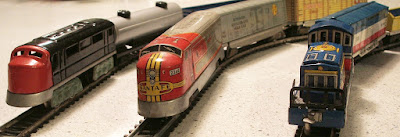And as with previous visits, there seemed to be a pattern to what we saw -- although I'm not entirely sure of the reason behind it. Each meet we notice an abundance of a particular item (or type of item). We find them in every hall, sometimes several on the same table. But the next meet, they're nowhere around.
The last meet we attended together, the 1957 Lionel Girl's Train -- normally an exceedingly rare piece -- was everywhere. And so was the modern reproductions of that set. This meet, I didn't see any at all.
This time it was complete sets, with all the boxes. And not just the standard sets one usually sees, but really unusual and rare sets. It's usually pretty easy to track down a Lionel General set from 1965 with the original box, and the Lionel/MPC Coke train is always around (Many people snapped it up when offered in 1974 thinking it would be a highly desirable collector's item. It never happened, and current pricing for a mint-in-the-box set is approaching original list price.)
 |
| Only purchase this set if you really like Coca-Cola. It is NOT collectable. |
The cheap
No, this time we saw a lot of Marx train sets, ranging from the 1940's through the 1960's. Now there are fairly rare because Marx trains were inexpensive, and unlike Lionel trains which might come out once a year for a Christmas display, were played with until the wheels fell off -- when they were thrown away. And when they were brought home, most Marx sets were taken out of their boxes (which were disposed of) and stored in the toy chest.
Remember, though, that value of any collectable is determined by three criteria: condition, scarcity, and desirability. Most of the Marx sets were in good shape for their age, and certainly rare, but many -- especially the most recent ones -- simply aren't that desirable. It was possible to pick up a complete set for as little as $40, which was actually a fair price.
Why were all of these inexpensive sets hitting the market at the same time? I don't know. My guess is that folks were trimming their collections, and sets take up a lot of room. But that's just a guess.
The very old
We also saw some pre-World War II trains sets in their boxes. This made a good deal of sense to me. Most toy collectors tend to collect items from their childhood -- either replacing long lost toys, or finally getting the awesome toys Santa never came through with. The founding members of the Train Collector's Association grew up in the early 1920's, so for a long time trains from that time period were the most desirable. My dad grew up in the lat 1930's so he's most interested in pre-war and early post-war trains. As for me, I like the trains from the mid 1960's, which is sort of the twilight of toy trains.
The point is, most of the first generation of collectors have either died or closed up housekeeping. Which dumps their collections back into the market. Now my dad's 80 this year, and while he's still living in own house, many of his generation have downsized. Seeing all the early pre-war sets wasn't surprising. But the scarcity of sets from 1935-1945 was. Those should also be coming back into circulation again.
The very odd
The rules for what can be sold at the meet are very strict. All items must be toy train or toy train-related. Sometimes the relationship's clear -- like Plasticville buildings, which virtually every O-gauge layout from the 1950's on seemed to have. And things like figures, toy cars, model trees, etc. also make sense.
But what about this? We saw no less than three Tootsietoy Fleet sets. There were all complete, in near-perfect condition, in their original set boxes. What't the toy train connect? Tootsietoy cars were used extensively in the 1930's on train layouts. Therefore, anything by Tootsietoy is "train-related" -- including battleships and aircraft carriers, I suppose.
 |
| The Tootsietoy aircraft carrier. Very difficult to find without at least one airplane's wings broken off. |
 |
| The Tootsietoy battleship from the Fleet set. Having all the turrets and masts intact is a rarity. |
I'm not sure. Perhaps the breaking up of the first generation's collections brought these to light. It would be consistent with the older train sets we saw (although better explained if there were more sets from the mid-1930's).
But that's part of the attraction. I know when we go back this fall, we won't see any of these sets. But we will see a lot of something else. But what? We won't know what that is until we get there!
#York




